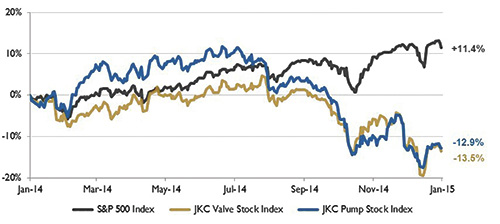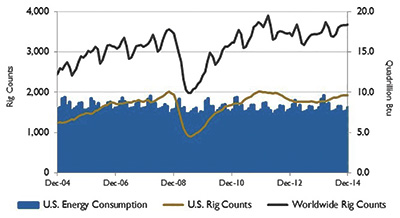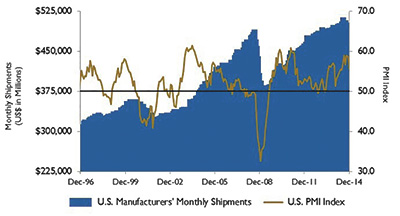The Jordan, Knauff & Company (JKC) Valve Stock Index was down 13.5 percent over the last 12 months, while the broader S&P 500 Index was up 11.4 percent. The JKC Pump Stock Index decreased 12.9 percent for the same time period.1 The Institute for Supply Management’s Purchasing Managers’ Index (PMI) decreased 3.2 percent from November’s reading to 55.5 percent. Manufacturing activity is moderating, shown by the fact that this is the third drop in the index in the past four months. Slowing demand from the energy industry caused by falling oil prices, the slowdown at West Coast ports and a slowing global economy are all impacting the PMI. Reflecting lower energy prices, the Price Index declined 6 percent to 38.5 in December, the lowest reading for prices since June 2012. The Employment Index rose 1.9 percent to 56.8 percent.
 Figure 1. Stock indices from Jan. 1, 2014, to Dec. 31, 2014. Source: Capital IQ and JKC research. Local currency converted to USD using historical spot rates. The JKC Pump and Valve Stock Indices include a select list of publicly traded companies involved in the pump and valve industries weighted by market capitalization.
Figure 1. Stock indices from Jan. 1, 2014, to Dec. 31, 2014. Source: Capital IQ and JKC research. Local currency converted to USD using historical spot rates. The JKC Pump and Valve Stock Indices include a select list of publicly traded companies involved in the pump and valve industries weighted by market capitalization. Figure 2. U.S. energy consumption and rig counts. Source: U.S. Energy Information Administration and Baker Hughes Inc.
Figure 2. U.S. energy consumption and rig counts. Source: U.S. Energy Information Administration and Baker Hughes Inc. Figure 3. U.S. PMI and manufacturing shipments. Source: Institute for Supply Management Manufacturing Report on Business and U.S. Census Bureau
Figure 3. U.S. PMI and manufacturing shipments. Source: Institute for Supply Management Manufacturing Report on Business and U.S. Census Bureau
